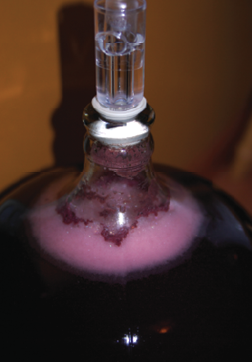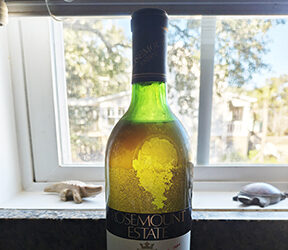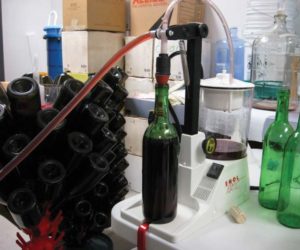Q
I have a 5-gallon (19-L) batch of blueberry wine that appears stuck. Here are the particulars: Two batches were made at the same time using the same recipe. The yeast was RC-212, prepared as a starter in advance of pitching. The yeast was pitched the following day after the temperature had stabilized and the must had a chance to become uniformly mixed. The berries were from the same picking. Both were prepared at the end of May 2013. Both were a little slow in primary fermentation. After several weeks, they were both taken off the fruit and racked to carboys, but left in the warm room for continued primary. During the subsequent month we were traveling, so the wine was not tended to. Upon our return, one batch had reached a specific gravity of 1.002 and was moved to a cooler location for secondary fermentation. The other batch stopped at 1.021 and has not progressed past that. I have twice added a packet of EC-118, added 2 tsp. of yeast energizer and put a heat belt around the carboy. What should I do?
John Price
Muncy Valley, Pennsylvania
A
Unfortunately, there are hundreds of possible causes of stuck and sluggish fermentations, and sometimes, even after careful investigation, we still can never understand what the cause may have been. With Mother Nature throwing us a different curve ball every year, add in the fact that the fruit always has a slightly different nutritional profile and you’re always making wine against a slightly different backdrop.
That being said, stuck and sluggish fermentations are most often caused by the following: Cold temperatures, inadequate yeast nutrition, microbial competition, unhealthy culture buildup/pitching technique and toxic ethanol levels towards the end of fermentation. Less often, they may be caused or exacerbated by low pH (high acid), pesticide residues, old yeast packets, opened/damaged yeast packets, too hot of a fermentation or high volatile acidity (VA) (often a byproduct of microbial competition). This is why it’s important to “check all the boxes” and do our best to mitigate any possible negative circumstances with our fermentations.
In your case, it’s strange you had two seemingly identical lots and one really stuck at higher sugar (1.021 SG, around 5.3 °Brix) and one almost finished (1.002 SG, around 0.52 °Brix). I would go through the above list and see if each lot was truly identical in its treatment. Was one lot in a colder spot in your cellar? Was one lot from part of the berry patch that may have had a pesticide accidentally sprayed on it? It’s so hard to tell.
The yeast you used, RC-212 can ferment up to around 16% alcohol so be sure to check your initial SG/Brix to make sure it would end up below that range once dry. You mention that both lots were a little slow to take off . . . RC-212 has what the manufacturer calls an “average” lag phase but is not more specific with how many days that may be. Be sure to download all information you can about your chosen yeast (usually called the “technical data sheet”) from the manufacturer’s website and follow directions to the letter. Specifically be sure that you scrutinize nutritional requirements and temperature requirements, and adjust your must accordingly to make sure final alcohol doesn’t go above the yeast’s maximum tolerance level.
As far as what to do to the wine now . . . you might want to try blending both lots together and see if you like the taste. If so, you could sterile filter, or fortify with spirits like brandy, and make a fortified dessert wine. With blueberries as your starting material, that might be a really nice taste option.
For the lot that is drier, I wouldn’t try to put it through a re-start. I find that when sugar is that low, the process of re-starting actually lowers the overall quality and you’re better off bottling slightly sweet (sterile filtered). However, let your taste be your guide. With your sweeter lot, I think you might want to give restarting a stuck fermentation a try. There is a good article by Jason Henrie on the procedure on the WineMaker website at http://winemakermag.com/story704. In my winery, I use the basic procedure published by Enartis/Vinquiry on their website, www.enartisvinquiry.com. Click on “Technical Information,” then “Winemaking,” then “Restart a Stuck or Sluggish Fermentation.” They do a great job taking you through the procedure.
Q
I’ve got a reoccurring problem with my estate red wines. For the past two years my Cabernet Franc fermentations have been stalling out when the specific gravity (S.G.) hits 1.000. Malolactic (ML) culture is added at this point and it does complete within a few weeks. Fearing spoilage problems, I added SO2 shortly after ML completion (based on pH using WineMaker’s sulfite calculator.) I started with an initial S.G. of 1.023, pH of 3.41 and titratable acidity of 6.4. I used D-254 with a properly prepared yeast starter and the maximum recommended amount of DAP and yeast nutrient, and fermented between 65-75 °F (18-24 °C). Secondly, It has been two months since the primary fermentation. Is it too late to re-ferment this batch of 35 gallons (132 L) of Cabernet Franc? What are the possible consequences of adding new yeast and nutrients at this point? It has been racked one time and has minimal lees.
Stan Sowinski
Falls, Pennsylvania
A
See my response to the earlier question starting on page 15 regarding general information about stuck and sluggish fermentations. Your wine is a lot closer to dryness (essentially 0 °Brix) than the previous reader’s sweetest lot, so I don’t know if I would recommend a re-start. When I’ve attempted re-starts below 0 °Brix, the extra added yeast and nutrients just make the mouthfeel and the nose of the wine “off.” Sometimes, I’ve even ended up with higher residual sugar than my initial batch!
The small amount of residual sugar you have may be enough to blend down if you think the wine is too sweet, if you have other wines that you can blend with it. You could try a re-start (see suggested resources on page 16) but I’m not sure I would recommend it.
You certainly want to try to focus on prevention, and on “checking all the boxes” that I list in the first answer. Your yeast choice, D-254, can safely ferment up to 16% alcohol, so your initial Brix of 23 should not have been a problem. All of the adjustments you did sound fine to me.
There are two things that strike me in this situation, however. Sometimes if malolactic fermentation (ML) happens concurrently with primary, the “bugs” (bacteria and yeast) all can compete for resources with each other, and one or both may be in danger of sticking. For this reason, I always choose to try to have primary fermentation finish before inoculating the wine with my ML strain. Try adding Lysozyme/Lactizyme (10-20 g/hL is what the manufacturers recommend) to your must in order to retard any wild ML strains that may want to gain a foothold, and inoculate with ML bacteria only after primary is complete.
You also may want to keep your fermentation on the skins a bit longer. Sometimes when pressing off with residual sugar still in the must (sometimes pressing itself releases latent sugar in the grape skins), the temperature drop from a warm, happy must to a cold press and stainless steel tank (or even “cold” barrel or carboy) can shock the yeast into slowing down or stopping. You may want to run a Clinitest® test or send out a wine sample to a wine lab to get an exact measurement of where you are. Sometimes S.G. and Brix at these low ranges can be tough to read accurately, especially if you are not using a hydrometer with a wide enough scale. Good luck!
Q
My wine’s pH is around 4.0 and it is currently undergoing a very strong malolactic fermentation (MLF). I know this will reduce the titratable acidity (TA) to some degree (already at around 6.5 g/L), which could result in a further elevated pH. My question is: Can I safely reduce pH after MLF is complete by adding tartaric acid? Could this help with aging and color stability? Also, do you recommend the use of any sorbate product post-MLF? I have heard that if the MLF is not fully complete, the sorbate can interact and cause odors.
Mike Donabedian
Vancouver, Washington
A
I absolutely recommend that you bring your TA up and your pH down after MLF is complete. This is best accomplished by tartaric acid, because wine bacteria will not consume tartaric acid; what you put in your wine will stay in your wine. This will certainly help with aging and color stability because both of these things are compromised by wines that have too high of a pH.
I am a big advocate of bench trials before you do a major adjustment to your wine like this. This will help you get the kind of numbers you need (probably at least a 1 g/L addition) without compromising the flavor. Or at least you will reach a “flavor compromise.” My ideal red wine pH post-MLF is around 3.50-3.75 depending on wine style goals and if you add too much acid your wine will taste tart with pronounced tannins.
Regarding potassium sorbate as a wine adjunct, I have to tell you I am not really a fan of it and rarely use it in my winemaking products. In fact, I only ever contemplated using it commercially once in a high-sugar, low-alcohol wine where I was worried about a yeast re-fermentation and wanted an extra level of security. However, I was able to achieve a 0.45 micron sterile filtration and had enough confidence to go to bottle without adding sorbate.
Potassium sorbate can indeed have an off-flavor and off-aroma. You should also be aware that it is only effective against yeast and not bacteria so it is of no use in retarding malolactic bacteria if you had residual malic acid remaining. Even if you have residual sugar in a fermentation, I am still a fan of sterile filtration instead of using potassium sorbate. I like to keep my wine as flaw-free and as intervention-free as possible and even small levels of potassium sorbate might throw something off balance. At the very least, tartaric acid is a naturally occurring grape acid, so if you adjust your pH with it, you are simply adding a little more of something that was already there to begin with.
Q
As a gourmet enthusiast, I have been curious to understand whether reducing (simmering) a red wine by approximately 3⁄4 will reduce its acidity? Thank you for any insight!
Diane Heath
via email
A
Making a red wine reduction is a great way to create a concentrated, flavorful sauce! I do it frequently myself when I’m cooking and it works great with red, white or sweet wines. Just be aware that when you have a cup or so of wine simmering away on the stove, what is simmering off is mostly water and alcohol. Everything else, the tannin, the sugar, the colored components and even the vast majority of the acids will remain in the pot as they are not light enough (volatile enough) compounds to “boil” off like steam or ethanol vapor. In a sense, you are concentrating all the flavored elements, including acids, so expect the result to be denser, more concentrated, and in fact more acidic than the original wine. This is why it is so common in reduction sauces to add a little sugar if it’s not there already.
One of my favorite procedures is as follows:
• Brown the meat of your choice in a hot cast iron skillet, flipping once. When meat is about 75% “done” to your liking (or to safe cooking temperature), remove to a plate in a medium-low oven.
• Drain all but about a tablespoon of the fat from the skillet, keep over medium heat and sauté about 2 tablespoons of finely chopped shallots until soft.
• Add about a cup of wine (red or white) to the pan and scrape up all the brown bits of “deglaze” with a wooden spoon.
• Add about a tablespoon of something sweet like honey, blackberry jam or redcurrant jelly and reduce mixture until syrupy. At this point, the volume should be about 4 to 5 tablespoons.
• Just before serving, whisk in about 2 tablespoons cold butter, cut into a few pieces, add about ¼ teaspoon finely chopped fresh thyme, a few grinds of pepper, a pinch of salt, then stir to incorporate and pour over your meat.
Bon appétit!
Related links:
• Using wines from around the world, Mikoli Weaver whips up a five-course menu that is sure to impress the guests in this story from the archives: http://winemakermag.com/story27
• In this column, the Wine Wizard mentions the option of making a fortified blueberry wine after fermentation became stuck. For more on making fortified fruit wines, read this story from June-July







